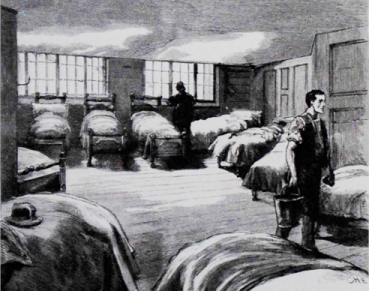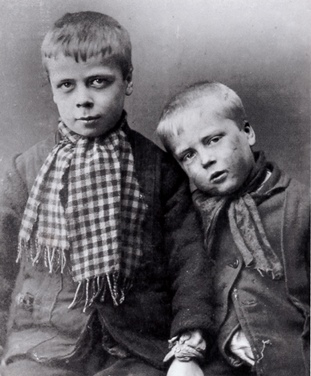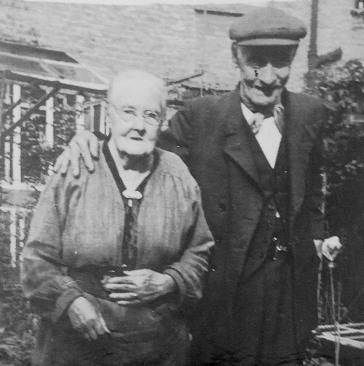joseph mallindine + alice maria manhood
Joseph was born at 14 Granby Street in Bethnal Green on 17 February 1851 and baptised at St Matthias on 14 March. He was the youngest son of Thomas Mallindine, a French Polisher, and his wife Susanna Sadler. Joseph’s mother died when he was just three years old and by the time he was seven, he was an orphan. He spent at least some of his childhood in the household of Stephen Sadler and his wife Mary Ann and although their relationship is not known, it seems likely that Stephen was his uncle. Stephen was a pastry cook by trade and Joseph, who worked as a baker and confectioner, no doubt learned the trade from him.

In 1871, twenty year old Joseph was lodging with the Turley family on Hope Street in Spitalfields and working as a baker. Hope Street extended north from Quaker Street between Grey Eagle Lane and Brick Lane — where Joseph lived with the Sadlers in 1861. The area around Hope Street was demolished when the Bishopsgate railway line was extended to link up with the new Liverpool Street station in the late 1870s.
By 1878, Joseph was living in a common lodging house at 5 Nichols Row. A lodging house, also known as a flophouse, was one of the lowest types of accommodation available and offered the poorest residents a place to sleep for a nightly fee. They slept together in common rooms and were forced to vacate the premises during the day even though many had nowhere else to go or seek shelter. The conditions in the lodging houses were so poor that the government and local authorities tried repeatedly to regulate them but without much success.
The lodging house appears to be the start of a desperate period in Joseph’s life as he was admitted to the Bethnal Green Workhouse on 8 February 1878 and discharged three days later. The record does not list the reason for his admission although it could have been illness, unemployment or homelessness. Joseph was readmitted to the workhouse on 22 July 1879 and discharged a week later and at that time, his last residence was listed as Dudlicks Lodging House but the location of the house was not given.
He does not appear in the 1881 census and if he was still living in lodging houses this may explain why — he would not have been home when the enumerator completed the census return. Two years later, Joseph was more settled and living at 102 Hackney Road and working as a confectioner. He married Alice Maria Manhood at St Jude in Bethnal Green on 13 May 1883. Joseph was 14 years older than Alice, who was born in Bethnal Green on 25 April 1865, the daughter of George William Manhood and Eliza Want. At the time, Alice was living in the Charlotte’s Buildings on Turville Street which was one street over from Nichols Row. The marriage record shows that both Joseph and Alice could read and write as they were able to sign the register.
It appears their marriage was one of necessity as their daughter Alice Eliza was born six months later on 4 November 1883. They were still living on Hackney Road and Joseph was back working as a pastry cook but at some point over the next three years, they left the East End and moved 55 Croydon Road in Plaistow, Essex. Joseph Thomas was born there on 4 September 1886 and baptised at Holy Trinity in Canning Town on 23 September. Second son Alfred Henry was born on 7 September 1889 and baptised at St Andrew on 25 September 1889. The baptism register listed his family’s home address as 5 New Road Sewell Street.
Two years later, Joseph and Alice were living at 5 King Street in Plaistow along with their three young children. Joseph was working as a confectioner but they were also earning extra income from two lodgers — Walter Willis, a 27 year old baker, and Agnes Wright a 45 year old, married laundress. Frederick Albert was born the following year and baptised on 1 November followed by Stephen George on 26 December 1894; when Stephen was baptised at St Mary the Virgin in Plaistow, the family was living at 2 Luton Road and Joseph was working as a Baker. Their son Frederick died in late May 1895 and was buried at Manor Park Cemetery. Daughter Lily Catherine was born in Plaistow in 1897.

1899
On 4 June 1898, Joseph died of tuberculosis at their home at 51 Tucker Street in Canning Town and he was buried three days later at the West Ham Cemetery in Newham; he was only 47 years old and due to his illness, he had been unable to work for six months prior to his death. His death left his family in a dire financial situation and although Alice received some relief from the parish and found employment, she did not earn enough to support herself and her children. Fifteen year old Alice Eliza was working as a domestic servant and twelve year old Joseph was sent to live in Norfolk but it is not known if he went to live with family or to work in exchange for food and lodging.
With no other options, Alice made the difficult decision to place her two youngest sons, Alfred and Stephen, in the care of the Dr. Barnardo’s organisation. On 1 May 1899, Alice took the boys to Barnardo’s, possibly the one in nearby Barkingside, and they were admitted that very same day. The boys were separated when ten year old Alfred was transferred to Leopold House in Limehouse where he remained for four months before being sent to Canada. Leopold House on Burdett Road opened in 1883 and after it was extended in 1887, it could accommodate over 450 boys between the ages of 10 and 13. Five year old Stephen was considered too young for emigration so he was boarded out first at Messing near Colchester and then at Palgrave near Diss on the Norfolk-Suffolk border. He returned to Leopold House and was sent to Canada in July 1904.
Dr. Barnardo’s
Thomas John Barnardo was an Irish physician who set up a charitable organization that was dedicated to the care of homeless and destitue children primarily in the East End of London. His first home was established in Stepney Causeway to provide food, clothing and education to poor children with the overall objective of giving them a better life. His organization set up a system whereby children were boarded out in rural areas until they were old enough to enter training schools to learn useful occupations so they could be placed in employment.
But his actions were not without controversy as he was accused on numerous occasions of taking children with their parent's consent and later of paying parents to hand their children over to his organization. The heaviest criticism came from Barnardo's involvement in the child migration scheme that was popular amongst philanthropic organizations in England from 1869 until after the First World War. Over 100 000 British children as young as ten years of age were sent to the British colonies of Australia, New Zealand, Canada and South Africa and fostered out to families where they received food and lodging in exchange for work. The philanthropists believed that they would have a healthier and more moral life in an idyllic rural setting but in fact, most of the children were simply seen as a source of cheap labour and many were mistreated and abused by their foster families. Once they emigrated, little follow up was done by organizations such as Barnardo's to ensure the children were properly cared for and the children themselves had little option but to stay with their foster parents as no other options were available to them.
Many young men sent to Canada as home children enlisted in the army at the start of the First World War in the hope of gaining passage to England to be reunited with their families following what was expected to be a short military engagement. But most of the children sent under the scheme never saw their families again.
On 25 March 1900, Alice gave birth to twins, Algernon and Jenny at her home at 103 Baron Road in Canning Town. They were registered under the surname Mallindine but both were given the middle name of Burt and their father’s name was listed as Frank Burt Mallindine. When the census was taken the following year, Alice gave her surname as Burt and indicated that she was married but no husband appears in the census return nor has a marriage record been found. She was living at 6 Beale Street North in Plaistow along with son Joseph, who was working as a bottle washer, daughter Lily and one year old twins Algernon and Jenny. Her eldest daughter, Alice Eliza, was living on Ley Street in Romford and working as a laundry maid.

In July 1901, Algernon and Jenny contracted measles and both were admitted to the infirmary at the Leytonstone Workhouse but there was no known treatment for the disease at the time and sadly both babies died. Jenny died first and was buried at Manor Park Cemetery on 30 July and Algernon on 9 August. In the fall of 1902, Alice had another son named Thomas and since his birth was registered under the name Thomas Burt Mallindine, it is assumed that he had the same father as the twins. Thomas later died but no death record has been found. After the tragedy of losing three children, Alice had something to celebrate when Alice Eliza married Henry Bayliss at the parish church in Ilford on 18 June 1905.
In 1911, Alice and her daughter Lily were living with Frank Talbot at 29 Seymour Road in Tilbury where they occupied 3 rooms. They were listed in the census as being husband and wife and married for 3 years but the only marriage record found is from 1914. Frank was born in Tottenham in 1866 and worked at the Port of London as a dock labourer. The census return also confirms that Alice gave birth to nine children but only five survived.
Her son Joseph had joined the Army and was serving as a Lance Corporal with the 13th Hussars in India. Joseph returned to England and married St Swithin Maud Walpole in Romford in 1920 and his sister Lily married Baden Powell Johnson on 20 May 1922. Alice Manhood died in East Ham in 1946.